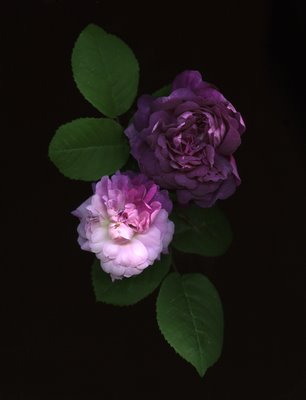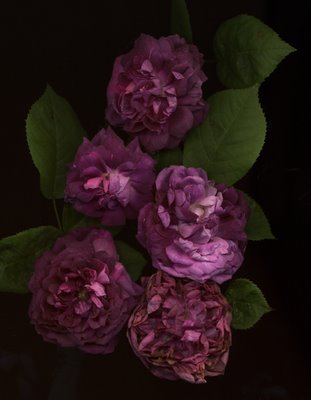A Somber Cardinal Richelieu Cheers Up
Monday, June 08, 2009

'Cardinal Richelieu'
Laffay France c. 1840
When I first started scanning my roses some years back my first intention was to use the process to accurately record the status of a particular rose on a particular day. I scanned them then and now at 100% size so that anybody perusing my files of roses (somewhere around 500 of them) would see a rose pretty well the way it appeared. When possible I try to make sure that my scan resembles the colour of the rose as closely as possible. As inaccurate as this may seem the result is far more accurate that that of either a film camera or a digital camera. The former will show roses with disparate colour depending on the film stock used (film stock is affected by latitude so that pictures taken further north will be a tad bluer) the time of day the pictures are taken or if they are taken on a cloudy day or under the shade of a tree. So few digital photographers have well calibrated monitor screens that the colour of a rose could be awfully suspect.

Anybody looking at these two different scans of the Gallica Rose, Cardinal Richelieu would be convinced they are not the same plant. The first one above is a scan I did today. The other one was June 18, 2007. The fading colour and the beautiful stage towards decay that most Gallicas have as an extra feature are here to be enjoyed. The rich purple flowers fade to a metallic bluish purple. What is strange that in a dryer and hotter spring, 2009, the bush seems to be later in comparison to 2007. The 2007 Cardinal had those spent blooms while today I found the open ones and there was one bud about to open.
Anybody looking at that first scan would wonder which rose is the real Cardinal Richelieu. For most of us who have enjoyed reading Alexandre Dumas’ Musketeer saga and seen all the films, Cardinal Richelieu is Vincent Price just like Lady de Winter was never better than when she was played by Lana Turner. Dumas’ Cardinal as a conniving power hungry cleric is mostly from the writer’s imagination. We do know that the Cardinal was a patron of the arts. Perhaps my particular plant is showing the man in his true colours and there was a gayer side of him we never knew. That would explain the less somber colour and the many shades of that one single but extraordinary bloom.






